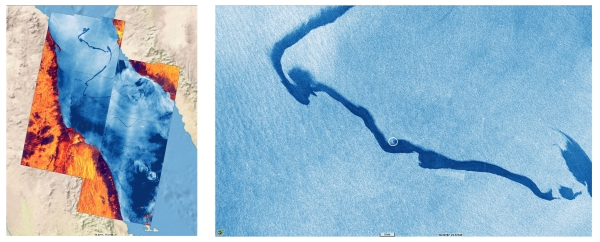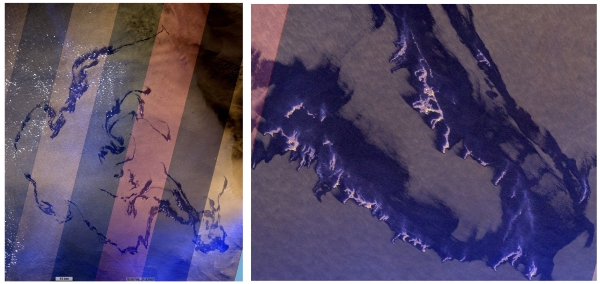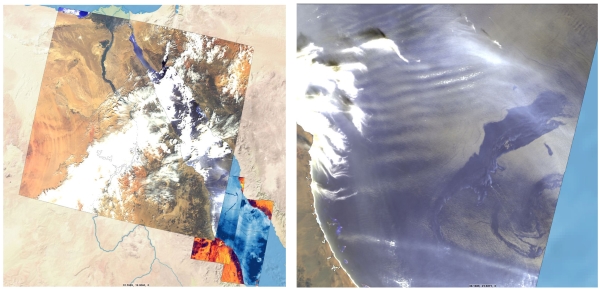On 11 October, some 95 km from the Saudi city of Jeddah, an Iranian-owned oil tanker was damaged, resulting in the loss of oil in the Red Sea. The Copernicus Sentinels are being used to monitor the resulting oil spill.
On 11 October, some 95 km from the Saudi city of Jeddah, an Iranian-owned oil tanker was damaged, resulting in the loss of oil in the Red Sea. The Copernicus Sentinels are being used to monitor the resulting oil spill.
The Sentinel-1, Sentinel-2 and Sentinel-3 satellite missions of the European Union's Copernicus Programme are working together to observe the 1,300 km long spill along the Red Sea.
Oil spills can harm marine life in oceans, estuaries, and wetlands. To limit their damage and assist clean-up efforts, emergency managers need fast information on spill location, size and extent, direction and speed of oil movement, along with wind, current, and wave details, for predicting oil drift and dispersion.
The main operational data requirements are timely turn-around and frequent imaging to monitor the dynamics of spills. Remote sensors on satellites meet most of these requirements by tracking the spilled oil at various resolutions, over wide areas, and at frequent intervals.
Launched on 3 April 2014 and followed by its twin on 22 April 2016, the Copernicus Sentinel‑1 satellites comprise a constellation of two polar-orbiting satellites, equipped with a C-band Synthetic Aperture Radar (C-SAR) instrument, operating day and night, enabling them to acquire imagery regardless of the weather.
Operating in four exclusive imaging modes with different resolution and coverage, Copernicus Sentinel-1 provides dual polarisation capability, very short revisit times and rapid product delivery—fundamental in such oil spill scenarios.
The radar signal is very sensitive to the viscosity of the water surface, and is therefore appropriate to detecting oil spills.
Copernicus Sentinel-2 is a wide-swath, high-resolution, multi-spectral imaging mission. The full mission specification of the twin satellites is designed to provide a revisit frequency of 5 days. These twin satellites benefit Copernicus services and applications such as land management, agriculture and forestry, water quality monitoring or emergency management.
Considered the workhorse of the Sentinels, the Copernicus Sentinel-3 mission is jointly operated by EUMETSAT and ESA to deliver operational ocean and land observation services. Carrying four main instruments, Ocean and Land Colour Instrument (OLCI), Sea and Land Surface Temperature Instrument (SLSTR), SAR Radar Altimeter (SRAL), and the Microwave Radiometer (MWR), the main objective of this mission is to measure sea surface topography, sea and land surface temperature, and ocean and land surface colour with high accuracy and reliability to support ocean forecasting systems, environmental monitoring and climate monitoring.
Serge Riazanoff, CEO at VisioTerra, states, "This example of major pollution in the Red Sea demonstrates the effectiveness and complementarity of Copernicus Sentinel data. The high temporal resolution of the observations make it possible to follow the evolution of the oil slick from day to day. Models of ocean currents (see a "2D_animation" on 13-14 October 2019" 12:00 GMT models) produced by the Copernicus Marine Environment Monitoring Service (CMEMS) and atmospheric models, such as surface winds (see a "2D_animation" on 13-14 October 2019 06:00 GMT models), produced by the Copernicus Atmosphere Monitoring Service (CAMS), enable to predict the drift of the oil spill. Eddies of marine currents in the Red Sea have stretched the slick over a length of 1,300 km, which demonstrate one of the greatest lengths of pollution ever observed to date".
About the Copernicus Sentinels
The Copernicus Sentinels are a fleet of dedicated EU-owned satellites, designed to deliver the wealth of data and imagery that are central to the European Union's Copernicus environmental programme.
The European Commission leads and coordinates this programme, to improve the management of the environment, safeguarding lives every day. ESA is in charge of the space component, responsible for developing the family of Copernicus Sentinel satellites on behalf of the European Union and ensuring the flow of data for the Copernicus services, while the operations of the Copernicus Sentinels have been entrusted to ESA and EUMETSAT.


